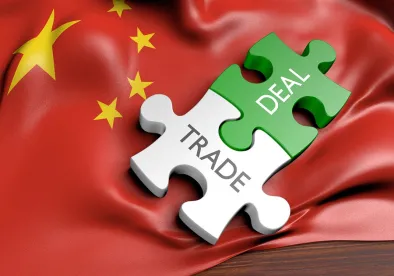On June 15, the Office of the U.S. Trade Representative (“USTR”) announced that the United States will implement a 25% ad valorem tariff on certain goods imported from China accounting for about $34 billion in annual trade. The USTR also requested comments on the proposed imposition of the same 25% tariff on other Chinese goods accounting for an additional $16 billion in annual trade. These measures arose from USTR’s investigation of certain acts, policies and practices of the Chinese government related to technology transfer, intellectual property and innovation. In its investigation, USTR determined that those acts, policies and practices were unreasonable or discriminatory and that they burden or restrict U.S. commerce. On that basis, USTR determined that the announced tariffs were an appropriate and feasible action under Section 301 of the Trade Act of 1974. The goods identified take aim at industrial sectors that are part of China’s Made in China 2025 initiative. The tariffs will be assessed in addition to all other applicable duties, fees, exactions and charges, including antidumping and countervailing duties.
The first phase of tariffs will be effective on July 6, 2018 with respect to all goods classified under certain tariff subheadings specified in USTR’s Notice of Action and Request for Public Comment (the “USTR Notice”), which was published in the Federal Register on June 20, 2018.
What to do Now?
Faced with a looming July 6 effective date, what should importers be doing now?
First, carefully review the list of 818 tariff subheadings that will be subject to Section 301 tariffs on July 6, as well as the list of 284 additional subheadings for which duties are proposed. The tariff subheadings subject to duties on July 6 are listed in Annex A of the USTR Notice. The additional 284 subheadings for which duties are proposed will be found in the Annex C.
Exclusion Request Procedure
In April, USTR initially proposed that the additional 25% duty be imposed on products falling under 1,333 tariff subheadings. After public comment and review, only 818 subheadings were identified for the first phase of tariffs on July 6. This was good news for importers of products that were removed from the list of covered products.
Even for importers of goods that are targeted for tariffs on July 6, there may still be hope for relief. The USTR Notice indicated that a procedure for requesting exclusions from tariffs will be established for U.S. stakeholders.
Earlier this year, the Commerce Department established a procedure for requesting exclusions from tariffs imposed on imported steel and aluminum under Section 232 of the Trade Expansion Act of 1962. Under those procedures, exclusions may be granted only if an article is not produced in the United States in a sufficient and reasonably available amount, or is not produced in a satisfactory quality, or if there is a specific national security consideration that would support exclusion.
Section 301 is based on a different rationale than Section 232, but similar concepts may also be reflected in the Section 301 exclusion process. USTR noted that, in its initial Section 301 exclusion process. USTR noted that, in its initial Section 301 review process, a number of interested persons commented that specific products within a particular tariff subheading were only available in China, that the Section 301 duties on specific products would cause severe economic harm to a U.S. interest, and that certain products were not strategically important to or related to the “Made in China 2025” program. It is possible that these factors will be considered by USTR in its exclusion procedures.
Public Comment on Proposed Additions to Section 301 Tariffs
For products that have been identified for potential future tariffs, there is also hope for relief. The USTR Notice established procedures for public comment on the list of tariff subheadings being considered for the second phase of tariffs. Written comments must be submitted by July 23, 2018. A public hearing will be held on July 24, 2018 and requests to appear at the public hearing must be submitted by June 29, 2018. Post-hearing rebuttal comments will be due on July 31, 2018.
USTR requests that commenters specifically address whether imposing duties on a particular subheading listed in Annex C would be practicable or effective to obtain the elimination of China’s acts, policies and practices, and whether maintaining or imposing additional duties on a particular product listed in Annex C would cause disproportionate economic harm to U.S. interests, including small or medium size businesses and consumers.
Consider Providing Comment and Making Exclusion Requests
All importers and users of additional products proposed for Section 301 tariffs should consider providing comments to USTR. Submission of comments can be effective in reducing the scope of the proposed tariffs. After consideration of comments in its initial review, USTR removed 515 tariff subheadings from the initial list of 1,333 proposed to be subject to the Section 301 tariffs.
While we wait for the Section 301 exclusion procedures to be announced, importers and users of products subject to the first phase of tariffs on July 6 should also consider whether there might be grounds for exclusion based on factors similar to those noted by interested persons in USTR’s initial Section 301 review or similar to those grounds established by the Commerce Department for Section 232 tariffs. Compiling tangible support for an exclusion request now will help expedite the filing process once the applicable procedures are announced.
What's Next?
China has threatened to retaliate with its own tariffs if the U.S. proceeds with the first phase of Section 301 tariffs. Those tariffs would be imposed on 545 U.S. products having an annual trade value equivalent to the value of the Section 301 tariffs. In response, President Trump has directed USTR to identify additional Chinese goods with a value of $200 billion that would be subject to an additional 10% tariff. The President has indicated that, if China retaliates against that action with additional tariffs, the retaliation will be met by more tariffs on additional Chinese goods having a value of $200 billion, potentially exposing Chinese goods with a total value of $450 billion to Section 301 tariffs.





 />i
/>i
